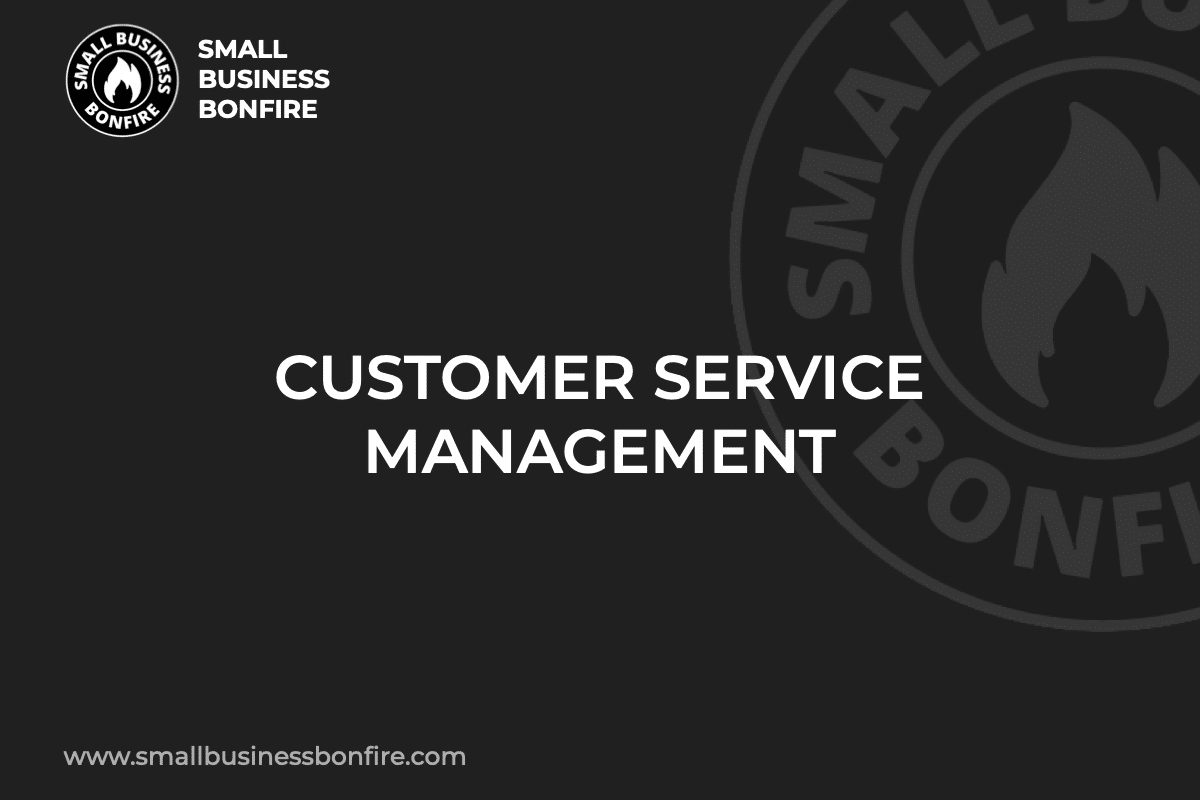Is your company drowning in customer complaints? Or maybe you’re having a hard time acquiring loyal customers!
Building customer loyalty is something several small businesses need help with.
Hi, my name is AJ! I started Small Business Bonfire to help answer entrepreneurs’ burning questions.
After selling my company for multiple seven figures, I want to prevent others from making the same mistakes I made.
One aspect that helped my team and I scale and secure more sales was emphasizing customer service management (CSM).
A customer-centric approach can change your business. Keep reading if you want to learn how to do this!
Key Takeaways
- Customer service management (CSM) can influence customer satisfaction and loyalty.
- CSM details the ways companies manage their relationships between themselves and their customers.
- CSM tools collect valuable customer data, providing decision and strategic planning insights.
- The benefits of CSM include actionable customer feedback and better customer experiences.
Related Reading: Best Small Business CRM
SBB Featured Partners
What Is Customer Service Management?
Customer service management (CSM) is how a business manages the relationship between itself and its customers.
Customer service is an essential aspect of every business,
At its core, customer service is the support your business offers your customers, whether it’s before or after the buying stage.
Why is it necessary to consider customer satisfaction?
Think about it: would you shop with a company that didn’t consider your needs or special conditions?
No. Instead, you would find a different brand that valued you and made the purchasing process as easy and enjoyable as possible.
Put simply, excellent customer support can lead to the following things:
- Higher customer loyalty rates
- More customer satisfaction
- Better product or service reviews
- More repeat customers
- Higher sales
Why is Managing Customer Service Essential?
Managing customer service is crucial because it directly influences the public’s perception of your brand.
For instance, effective customer service management fosters trust and loyalty, leading to repeat business and positive word-of-mouth marketing.
Also, it allows for fast problem-solving solutions, preventing minor issues from escalating into significant pitfalls.
Good customer service management also provides valuable insights into customers’ needs, aiding in product development and improving overall business processes.
Lastly, CSM sets you apart from competitors, establishing your brand as a customer-centric business in an increasingly competitive marketplace.
Benefits of Customer Service Management
There are three primary advantages to implementing a customer service management strategy.
For example, these benefits include the following:
- Actionable customer feedback
- Better customer experiences
- Better internal business processes
Here’s what you must know about each of these advantages!
Actionable Customer Feedback
Actionable customer feedback is vital for small businesses because it provides insights into what customers like or dislike about your products, services, and overall business operations.
Also, by paying attention to customer feedback, your business can make necessary adjustments to its offerings and improve its performance, which enhances customer satisfaction.
Further, such data-driven decision-making fosters a customer-centric approach, which can significantly contribute to increased sales!
Improved Customer Experience
Improved customer experiences are another benefit of customer service management.
For instance, better customer shopping experiences increase customer satisfaction and retention rates.
Businesses can personalize interactions by understanding and responding promptly to customer needs, making customers feel valued and appreciated.
Also, a positive customer experience often translates into the following things:
- Repeat business
- Customer referrals
- Positive online reviews
These actions all contribute to increased profitability and a more substantial brand reputation!
Better Internal Processes
Better internal processes resulting from effective customer service management can significantly enhance business metrics.
Because streamlined processes increase efficiency, it reduces the likelihood of errors.
Typically, when companies make errors, it negatively impacts the customer experience.
In addition, well-structured internal processes can lead to the following things:
- Improve communication within the organization
- Quicker resolution of customer queries and complaints
- Boost in customer satisfaction
- Happier and more efficient employees
The Importance of Customer Service to B2B Organizations
In B2B scenarios, the significance of customer service cannot be understated.
For example, excellent customer support forms the foundation of long-term business relationships.
Long-term relationships are especially vital in B2B interactions, where contracts are often more extensive and enduring.
Also, high-quality customer service facilitates trust-building and positions your business as a reliable partner, increasing the likelihood of repeat business.
Lastly, CSM gives your business a competitive edge, as B2B clients, like B2C customers, prefer to engage with companies that demonstrate exceptional customer service!
The Importance of Customer Service to B2C Organizations
Customer service is vital to B2C organizations because it is often the primary point of interaction between the business and its customers.
Further, high-quality customer support does the following things for a business:
- Creates a positive impression
- Fosters brand loyalty
- Encourages repeat business
- Boosts sales
Also, exceptional customer service management helps resolve issues promptly, leaving customers feeling valued and appreciated.
Lastly, emphasizing customer support provides businesses valuable feedback that teams can use to improve products and services, enhancing the overall customer experience!
How to Improve Customer Service Management
It’s always a good idea to continually look for ways to improve your company’s customer service management strategy.
Fortunately, there are several ways to improve customer interactions.
Below, I’ve listed numerous strategies customer service teams can implement to enhance shopping experiences!
Utilize Customer Relationship Management (CRM) Software
Utilizing customer relationship management (CRM) software is beneficial because it organizes and centralizes all customer-related data.
As a result, teams can make quick and informed decisions.
Also, the software can do the following things:
- Use automation and analytics to enhance customer interactions
- Personalize marketing strategies
- Provide valuable insights into customer behavior
- Improve customer satisfaction
- Utilize social media to cater to a business’s target audience
CRM systems are highly advanced, allowing your employees to focus on customer-centric tasks rather than data analysis and repetitive tasks.
Implement a Comprehensive Training Program
Implementing a comprehensive training program equips customer service teams with the necessary skills to handle any inquiries or complaints effectively.
Further, training enhances their communication and problem-solving abilities and fosters empathy, improving customer loyalty.
Remember, some employees may go through training faster than others.
Ensuring all employees have the knowledge and tools necessary to offer exceptional client support is essential!
Monitor and Respond to Customer Feedback
Monitoring and responding to customer feedback is crucial because it helps companies understand what’s working well and what needs improvement.
By acknowledging and acting upon this feedback, businesses demonstrate the following things:
- A commitment to customers
- The importance of making informed decisions
- A commitment to improving experiences across multiple channels
Provide Multi-Channel Support
Providing multi-channel support is essential because it enables businesses to meet customers where they are.
For instance, multi-channel support means companies help customers through the following outlets:
- Phone
- Social media
- Live chat
The multi-channel support approach enhances customer convenience and fosters better communication.
Ensure Clear and Efficient Communication
Clear and efficient communication is vital for customer service representatives because it fosters customer understanding and trust.
As a result, customer service managers and reps can effectively address customer concerns or inquiries.
Also, clear communication ensures customers receive consistent, accurate information about products or services.
Personalize Customer Experiences
Personalizing customer experiences is crucial because it creates a deeper connection between the customer and the brand.
Further, personalized experiences help customers feel valued and understood, increasing the likelihood of repeat business and positive word-of-mouth referrals (free advertising!).
Develop a Customer-Centric Culture
Developing a customer-centric culture is integral to the success of a business.
When companies put customers first, they show they prioritize customer satisfaction at every level of the organization.
Also, a customer-centric culture ensures all business processes, from product development to sales and customer service, are designed with the customer’s needs and expectations in mind.
Implement a Robust Problem-Resolution Process
Implementing a problem-resolution process drastically enhances a company’s ability to address and correct customer issues.
Therefore, companies demonstrate respect for the customer’s time and experience.
Use Data Analytics for Continuous Improvement
Leveraging data analytics in real-time for continuous improvement is pivotal because it offers invaluable insights into the following things:
- Customer behavior
- Customer needs
- Buying preferences
As a result of using data analytics, businesses can tailor their marketing and sales strategies accordingly.
Regularly Evaluate and Adjust Service Strategies
Regularly evaluating and adjusting service strategies is crucial for businesses to keep up with evolving customer expectations, preferences, and market trends.
This continual refinement ensures that your customer service remains relevant, effective, and aligned with your business goals.
Motivate Your Customer Service Team with Rewards
Rewards are an excellent way to motivate customer service managers and reps (trust me on this one).
You can reward your support team for the following things:
- Customers who leave positive reviews regarding their support experience
- How fast reps handle inquiries and problems
- The number of support requests reps solve
Innovate with Artificial Intelligence
Support teams can leverage artificial intelligence (AI) to streamline operations and enhance customer experiences.
For example, AI-powered chatbots can handle routine inquiries, freeing up human agents to focus on more complex issues.
Also, machine learning algorithms can analyze data to predict customer behavior and personalize interactions.
Establish a Customer Feedback Loop
A customer feedback loop is a strategy businesses employ to gather, analyze, and respond to customer feedback, ensuring continuous product or service quality improvement.
Further, a feedback loop allows companies to understand customer needs and experiences by closing the gap between customer expectations and the actual product or service experience.
Customer Service Management Examples
What are some examples of customer service management?
Check out these six techniques that can help boost your customer support game!
Customer Relationship Management (CRM) Software
Customer relationship management (CRM) software is a comprehensive tool that helps businesses manage and analyze data throughout the customer lifecycle.
Further, CRM software does the following things:
- Improves customer service relationships
- Assists in customer retention
- Drives sales growth
Marketing Automation
Marketing automation streamlines, automates, and measures marketing tasks and workflows.
For example, some tasks marketing automation handles include the following:
- Scheduling social media posts
- Sending emails
- Sending meeting reminders
- Data entry
- Organizing and analyzing data
Automation is truly a game-changer for any business! The features save time and allow your marketing team to do what they do best: get creative and attract customers!
Omni-Channel Workflow Management
Omni-channel workflow management is a holistic approach to customer service that ensures a seamless customer experience across all platforms.
So, whether your customers shop in-store, online, or through mobile apps, your support team is there to help!
Omni-channel management integrates all touchpoints and communication channels a business uses to interact with its customers.
AI-Powered Chatbots
AI-powered chatbots are revolutionizing customer support by automating the handling of routine inquiries, freeing time for human agents to focus on complex issues.
In addition, these intelligent bots can do the following things:
- Analyze data to predict customer behavior
- Help businesses personalize their customer interactions
- Ensure timely and efficient service
Social Media
Social media is a powerful customer service management example that allows businesses to engage directly with customers and resolve issues in real time.
Further, these outlets allow companies to do the following things:
- Provide rapid responses to customer inquiries and feedback
- Foster a dialogue that enhances customer relationships
- Leverage a public-facing platform to showcase the company’s dedication to its customers
Video
Video can be a powerful tool in customer service management, enabling businesses to deliver personalized and in-depth solutions to customer problems.
Besides, video tutorials or live video assistance can provide visual aids to customers, simplifying complex instructions.
Typical Steps for Customer Service Management
Here’s how (most) customer service management situations go!
Step 1: Customer Files a Ticket
The beginning of the customer service management process is when a customer files a ticket.
Filing a ticket can mean a customer has a question about their order or requests for more information.
Whatever the reasoning, a ticket means a customer is contacting your support team.
Step 2: Update Customer
The second step is updating the customer.
At this point, a service rep must reply to the customer’s question or problem.
Timely responses are crucial because no one likes waiting around for answers!
Step 3: Escalate a Ticket
When issues are particularly complex, reps might have to escalate the ticket to a higher-level team or customer service manager.
While escalating tickets are rare, it’s essential to have a solution in place in case it happens.
Even with complex issues, it’s critical for your customers to feel you assign the best-qualified staff to take care of the problem.
Step 4: Triage & Resolve the Ticket
Triaging ensures each task is assigned to the proper agent.
As a result, support tickets are assigned to individuals who are best suited to handle the problem.
Also, triaging ensures a support team resolves tickets efficiently.
Step 5: Close the Ticket
After your team resolves a customer’s ticket to their satisfaction, they must close the ticket.
Before officially closing a ticket, collect the data associated with the inquiry or request for future reference.
How to Structure Your Customer Service Management Department
Structuring a customer service management department properly is crucial because it ensures your team is efficient and productive.
Here is the four-step process for structuring your CSM department!
Step 1: Define Your CSM Goals
Defining your CSM goals is an essential first step for structuring your department.
Setting goals provides clear direction and focus.
Also, clearly defined goals give your support team something to work toward.
For instance, CSM goals could include:
- Reducing response times
- Increasing customer retention rates
- Improving the quality of support provided through customer feedback
Step 2: Understand the Support Your Customers Need
Understanding your customers’ support needs is imperative in the world of customer service management.
When you understand common queries your audience has, this knowledge allows your company to provide tailored and practical solutions.
Step 3: Empower Your Employees with Growth Opportunities
Empowerment is an essential aspect of any customer support department.
Providing team members with opportunities to grow and develop their skills can lead to a more engaged and motivated workforce.
Also, providing growth opportunities leads to lower employee turnover rates.
Step 4: Support Your Virtual Customer Service Team
Even when customer service teams are virtual, showing them they’re valued team members is crucial!
After all, your support services couldn’t function if it weren’t for these individuals.
Offering growth opportunities and maintaining an open line of communication are two easy ways to support your virtual customer support staff.
Keep Your Customer Service Management Roles Fresh
How do you ensure your customer support staff is up to date with the latest industry trends?
There are three integral roles of your customer service team, including the following:
- Customer training
- Employee training
- Knowledge manager
Let’s look at each of these roles in greater detail!
Role 1: Customer Training
When it comes to your products or services, your customer service reps understand them better than most people in your company.
Further, these employees have significant experience with the things your company offers.
Therefore, they can predict issues and questions customers will have.
Why not take advantage of this knowledge?
What I mean is this: have your customer service reps share their knowledge with your customers.
Offering transparency about your products and services provides a layer of additional trust between your brand and its consumers.
So, while some business owners view customer training as a bad thing, it’s actually quite beneficial when you consider the long-term results!
Role 2: Employee Training
One advantage of maintaining a well-trained staff is that the employees can learn from each other.
For instance, if one employee has more experience working with the company, they can guide recent hires on certain aspects of the job.
As a result, your customer service staff trains and betters each other!
Additionally, support reps might have advice for other departments of your company, like production or marketing.
Let’s say your support team continuously receives complaints about how the products look online compared to in real life.
Customer support teams can bring this information to the marketing department, ensuring your future campaigns present the product how it actually looks!
Support agents spend most of their day hearing the things customers would change about your products or services.
Rather than getting upset about the complaints, use them as learning opportunities!
Role 3: Knowledge Manager
An excellent way to gather, organize, and store valuable support agent knowledge is a knowledge base!
Allow support reps to write knowledge articles about your company’s products or services.
Another great option is having support teams review FAQs on your business’s website so they can share their insights!
Again, it would be silly to let the insights service staff have to go to waste.
Is CSM the Same as CRM?
While both customer service management and customer relationship management prioritize customer satisfaction, they focus on different aspects of the customer journey.
For instance, CSM is primarily concerned with delivering and optimizing customer support services.
Further, effective customer service management involves the following things:
- Managing customer inquiries
- Resolving issues
- Ensuring a smooth service experience
On the other hand, CRM is a broader concept that encompasses all interactions a business has with its customers.
For example, CRM software is about building and nurturing long-term customer relationships.
Also, a CRM system typically includes the following types of features:
- Sales management tools
- Marketing data and analytics
- Customer service tools
- Automation
In essence, while CSM is a crucial component of CRM, they are not the same.
Instead, think of CSM as one piece of the larger CRM puzzle, focusing on customer relationship management’s support and service aspect.
Customer Service Management Final Thoughts
There’s everything you need to know about customer service management!
At its core, CSM is how a company manages and handles its customer service branch.
Remember, customer service is an integral aspect of any business because it results in more repeat customers, word-of-mouth advertising, and more sales overall!
What aspects of CSM will you implement into your business? Let us know in the comments section below!
And best of luck implementing a new CSM strategy!
Newsletter Signup
Join The Leads Field Guide Newsletter for tips, strategies and (free) resources for growing your leads, and closing more deals.




